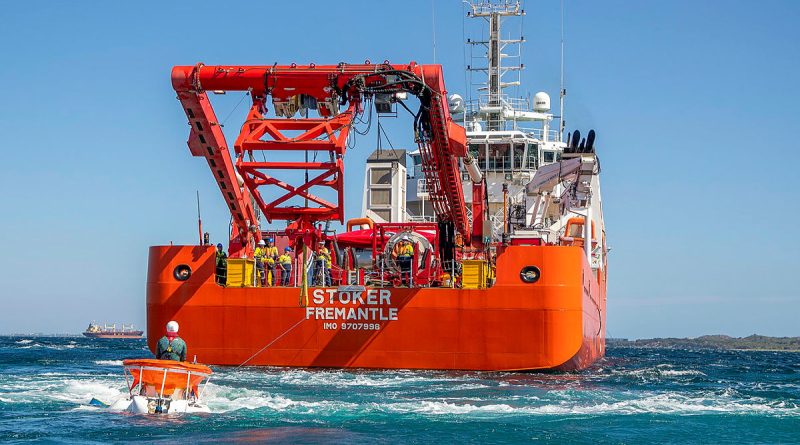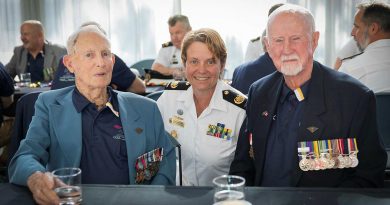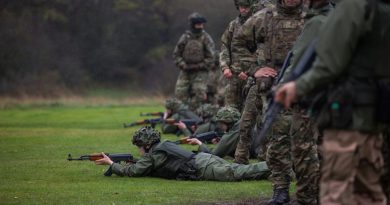Teamwork key to submarine rescue exercise

Navy’s submarine abandonment, escape and rescue (SAER) system was certified for another year as part of the annual Exercise Black Carillon, which ran from February 13-24.
CAPTION: Defence industry partner JFD’s LR5 rescue vessel is retrieved by rescue gear ship Stoker during Exercise Black Carillon off the coast of Western Australia. Story by Lieutenant Mick Wheeler. All photos by Leading Seaman Ernesto Sanchez.
The exercise, conducted off the coast of Western Australia, included international observers from Indonesia, Japan, Malaysia, Singapore, Thailand and Vietnam.
The Australian Submarine Rescue System (ASRS), which is maintained and operated by industry partner JFD, was designed to be transported by sea, land or air to locate a disabled submarine (DISSUB) and rescue its crew.
Navy and private enterprise personnel jointly conduct the exercise each year to ensure they meet the appropriate requirements and are ready to conduct a SAER operation at short notice.
Navy’s SAER capability is recognised by the global International Submarine Escape and Rescue Liaison Office, where submarine operating nations can call on each other for assistance in the event of a submarine search-and-rescue operation.
Exercise Director Commander Darren White said the aim of the exercise was to validate and exercise Navy’s SAER capability.
“The focus of this exercise was to practise and prove established escape-and-rescue procedures for the recovery of personnel from a simulated disabled DISSUB,” he said.
“In the event of a real-world DISSUB situation, mariners and submariners from across the world would provide specialised skills and equipment to assist in the localisation, rescue and recovery of survivors.

CAPTION: Underwater doctor Lieutenant Patrick Owens, right, gives international officers and observers a tour inside a bariatric chamber.
“The purpose of these exercises and the attendance of our international friends is not only an opportunity to demonstrate our capability, but also an opportunity for us to network and share experiences and lessons learnt in the area of submarine abandonment, search and rescue.”
During the sea phase of the exercise a side-scan sonar was deployed from the submarine intervention gear ship Besant, to locate either a bottomed submarine or pre-positioned target plate.
Thereafter a remotely operated vessel (ROV) was dived to the DISSUB site to assess the situation, remove debris and clean the rescue seat if necessary.
JFD Manager Greg Cotton said it was imperative the ROV was deployed prior to the rescue vehicle being put into the water.
“This gives us a visual survey of the submarine and allows us to know what state the rescue seat is in,” he said.
“From the ROV dive we can see if the rescue seat is fouled in any way, deformed and so on.
“That would give us an indication of whether the rescue vehicle, in this case LR5, is capable of “mating” with the submarine and conducting a rescue.”
When the rescue seat was assessed and deemed intact, Besant recovered the ROV and moved aside for the rescue gear ship Stoker to deploy the LR5 rescue vessel.
Once in the water, the LR5 “mated” with the submarine and conducted a staged transfer of personnel from the stricken submarine to the rescue ship, where they had immediate access to a range of medical facilities, including decompression chambers if required.
Indonesian submariner Lieutenant Commander Hendra Siregar said Black Carillon was a valuable exercise to observe.
“This exercise is very important for submariners because we need to be united and learn from each other if there is a situation where a submarine becomes disabled,” he said.
“This has been a very valuable experience for me as I was given plenty of opportunities to watch the LR5 and the ROV at work.”
The international observers were rotated between Besant and Stoker in order to observe the individual vessels operating their respective SAER capability.
Japan Maritime Self Defense Force submariner Commander Satoshi Koizumi said the exercise provided a wealth of valuable experience for the observers.
“From a Japanese point of view, Black Carillon offers a good opportunity to learn how the RAN carry out submarine rescue,” he said.
“Knowing what other countries can do is important as I now know the capability that we can call on in the event of a real submarine search and rescue event.”

CAPTION: International observers and officers watch the rescue vessel being recovered during Exercise Black Carillon.
.
.

.
.





